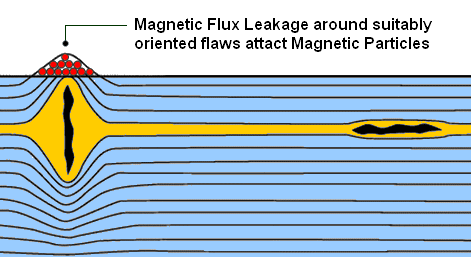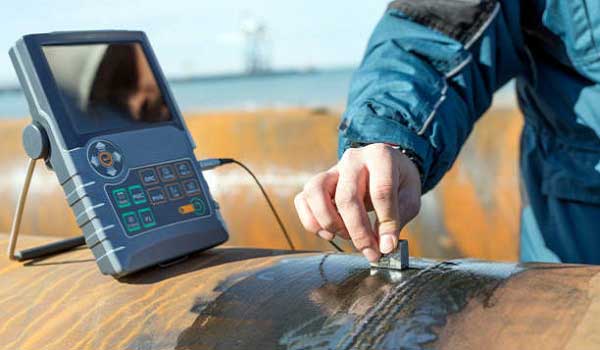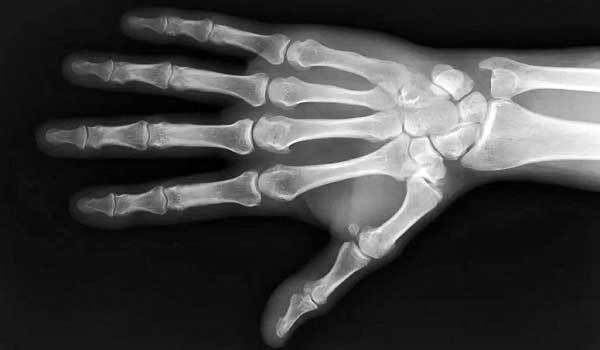Magnetic Particle Inspection (MPI) |
Magnetic particle inspection (often abbreviated MT or MPI) is a nondestructive inspection method that provides detection of linear flaws located at or near the surface of ferromagnetic materials. It is viewed primarily as a surface examination method.
Magnetic Particle Inspection (MPI) is a very effective method for location of surface breaking and slight sub-surface defects such as cracking, pores, cold lap, lack of sidewall fusion in welds etc in magnetic materials.
There are many different techniques. The most versatile technique is using a 110v AC hand held electromagnetic yoke magnet, a white strippable paint as contrast background and a magnetic "ink" composed of iron powder particles in a liquid carrier base.
The area is magnetised with the yoke magnet. In the event of a surface or slightly sub surface defect being present, the lines of magnetic force will deform around the defect.
The magnetic ink is applied and the iron powder particles will bridge the gap caused by the defect and give a visible indication against the white contrast background.
Magnetic Particle Inspection (MPI) provides very good defect resolution and is used extensively
on..
Welded fabrications in magnetic material, Castings, Locating fatigue cracks in items subject to
cyclical stress

Schematic of flux lines flowing past both a perpendicular and parallel defect, and flux leakage occurring around the perpendicular flaw
Magnetic Particle Inspection is performed in four steps..
- Induce a magnetic field in the specimen
- Apply magnetic particles to the specimen's surface
- View the surface, looking for particle groupings that are caused by defects
- Demagnetize and clean the specimen
Advantages of Magnetic Particle Inspection
- Can find both surface and near sub-surface defects
- Some inspection formats are extremely portable and low cost
- Rapid inspection with immediate results
- Indications are visible to the inspector directly on the specimen surface
- Can detect defects that have been smeared over
- Can inspect parts with irregular shapes (external splines, crankshafts, connecting rods, etc.)
Limitations of Magnetic Particle Inspection
- The specimen must be ferromagnetic (e.g. steel, cast iron)
- Paint thicker than about 0.005" must be removed before inspection
- Post cleaning and post demagnetization is often necessary
- Maximum depth sensitivity is typically quoted as 0.100" (deeper under perfect conditions)
- Alignment between magnetic flux and defect is important

Standards
StandardsInternational Organization for Standardization (ISO)
- ISO 3059, Non-destructive testing - Penetrant testing and magnetic particle testing - Viewing conditions
- ISO 9934-1, Non-destructive testing - Magnetic particle testing - Part 1.. General principles
- ISO 9934-2, Non-destructive testing - Magnetic particle testing - Part 2.. Detection media
- ISO 9934-3, Non-destructive testing - Magnetic particle testing - Part 3.. Equipment
- ISO 17638, Non-destructive testing of welds - Magnetic particle testing
- ISO 23279, Non-destructive testing of welds - Magnetic particle testing of welds - Acceptance levels
European Committee for Standardization (CEN)
- EN 1290, Surface Crack Testing
- EN 1330-7, Non-destructive testing - Terminology - Part 7.. Terms used in magnetic particle testing
- EN 1369, Founding - Magnetic particle inspection
- N 10228-1, Non-destructive testing of steel forgings - Part 1.. Magnetic particle inspection
- EN 10246-12, Non-destructive testing of steel tubes - Part 12.. Magnetic particle inspection of seamless and welded ferromagnetic steel tubes for the detection of surface imperfections
- EN 10246-18, Non-destructive testing of steel tubes - Part 18.. Magnetic particle inspection of the tube ends of seamless and welded ferromagnetic steel tubes for the detection of laminar imperfections
American Society of Testing and Materials (ASTM)
- ASTM E1444-05
- ASTM A 275/A 275M Test Method for Magnetic Particle Examination of Steel Forgings
- ASTM A456 Specification for Magnetic Particle Inspection of Large Crankshaft Forgings
- ASTM E543 Practice Standard Specification for Evaluating Agencies that Performing Nondestructive Testing
- ASTM E 709 Guide for Magnetic Particle Testing Examination
- ASTM E 1316 Terminology for Nondestructive Examinations
- ASTM E 2297 Standard Guide for Use of UV-A and Visible Light source and Meters used in the Liquid Penetrant and Magnetic Particle Methods
Related Post(s)

Ultrasonic nondestructive testing is a method of characterizing the thickness or internal structure of a test piece through the use of...

Radiographic Testing (RT or X-ray or Gamma ray) is a non-destructive testing (NDT) method that examines the volume of a specimen.